Risk Management Policy, Procedure, and Implementation in Healthcare
VerifiedAdded on 2022/08/21
|6
|1075
|14
Report
AI Summary
This report provides a comprehensive overview of risk management policies and procedures within healthcare organizations. It defines key risk management terms such as risk prevention, risk reduction, regulatory compliance, patient safety, adverse events, and near misses. The report identifies major risk categories in healthcare, including compliance lapses, cyber threats, physical attacks, and healthcare-related illnesses, and suggests corresponding risk identification techniques. It details risk management strategies for dealing with physical attacks, health illnesses, and privacy and information security breaches. Furthermore, the report emphasizes the risk manager's role in program implementation and compliance, highlighting the importance of effective policies and procedures for mitigating risks to patients, staff, and the organization. The document is available on Desklib, a platform offering a wide range of study tools and solved assignments for students.
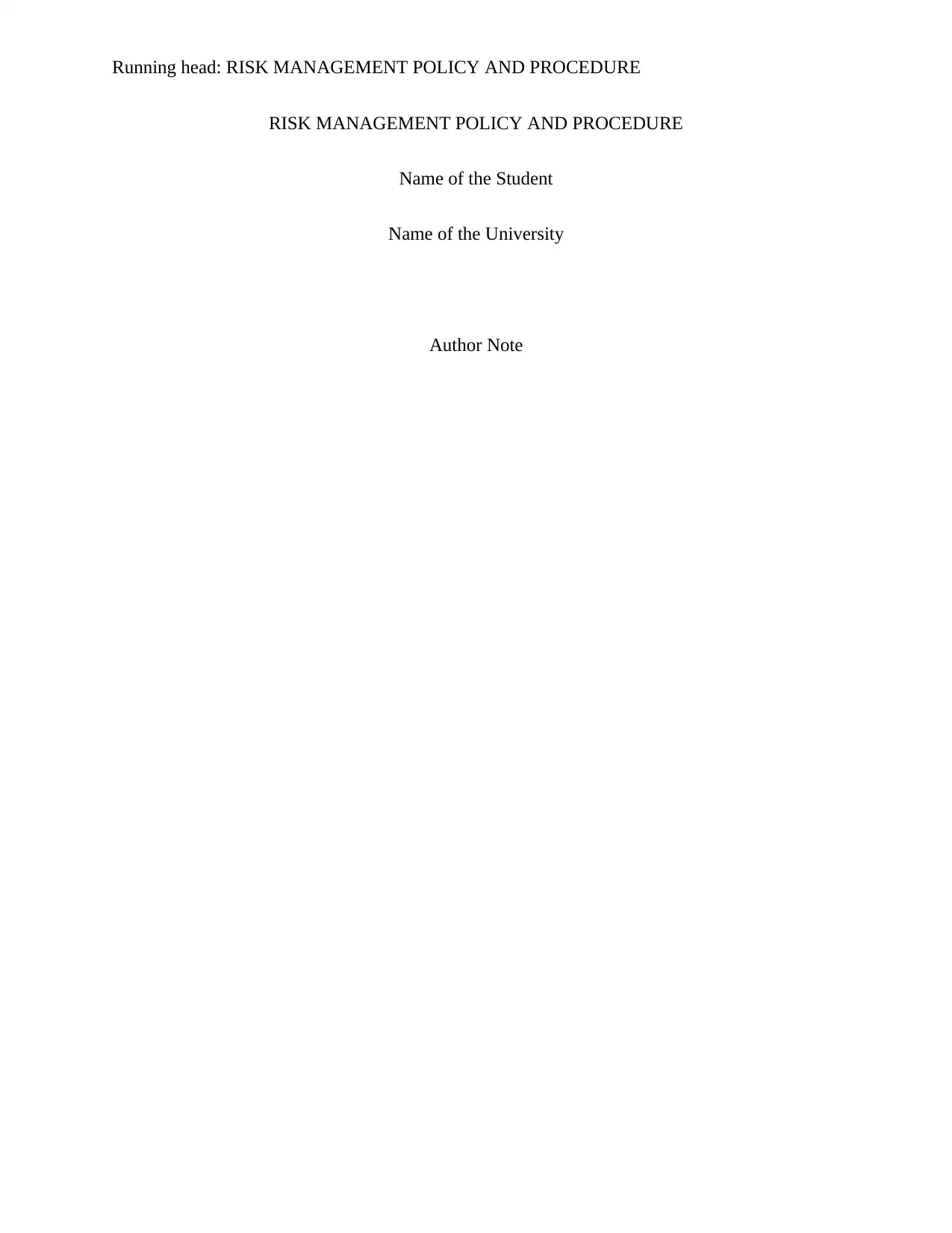
Running head: RISK MANAGEMENT POLICY AND PROCEDURE
RISK MANAGEMENT POLICY AND PROCEDURE
Name of the Student
Name of the University
Author Note
RISK MANAGEMENT POLICY AND PROCEDURE
Name of the Student
Name of the University
Author Note
Paraphrase This Document
Need a fresh take? Get an instant paraphrase of this document with our AI Paraphraser
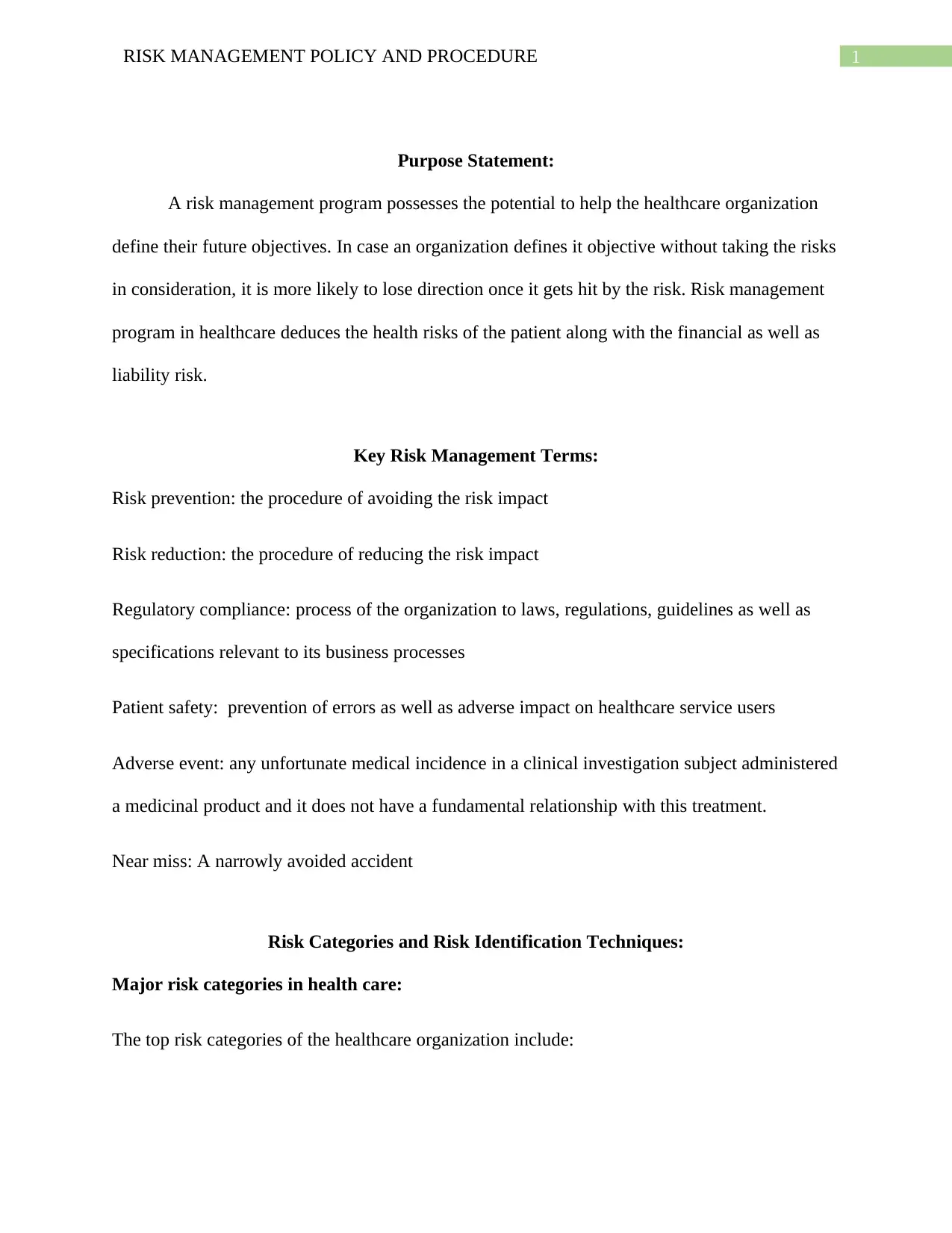
1RISK MANAGEMENT POLICY AND PROCEDURE
Purpose Statement:
A risk management program possesses the potential to help the healthcare organization
define their future objectives. In case an organization defines it objective without taking the risks
in consideration, it is more likely to lose direction once it gets hit by the risk. Risk management
program in healthcare deduces the health risks of the patient along with the financial as well as
liability risk.
Key Risk Management Terms:
Risk prevention: the procedure of avoiding the risk impact
Risk reduction: the procedure of reducing the risk impact
Regulatory compliance: process of the organization to laws, regulations, guidelines as well as
specifications relevant to its business processes
Patient safety: prevention of errors as well as adverse impact on healthcare service users
Adverse event: any unfortunate medical incidence in a clinical investigation subject administered
a medicinal product and it does not have a fundamental relationship with this treatment.
Near miss: A narrowly avoided accident
Risk Categories and Risk Identification Techniques:
Major risk categories in health care:
The top risk categories of the healthcare organization include:
Purpose Statement:
A risk management program possesses the potential to help the healthcare organization
define their future objectives. In case an organization defines it objective without taking the risks
in consideration, it is more likely to lose direction once it gets hit by the risk. Risk management
program in healthcare deduces the health risks of the patient along with the financial as well as
liability risk.
Key Risk Management Terms:
Risk prevention: the procedure of avoiding the risk impact
Risk reduction: the procedure of reducing the risk impact
Regulatory compliance: process of the organization to laws, regulations, guidelines as well as
specifications relevant to its business processes
Patient safety: prevention of errors as well as adverse impact on healthcare service users
Adverse event: any unfortunate medical incidence in a clinical investigation subject administered
a medicinal product and it does not have a fundamental relationship with this treatment.
Near miss: A narrowly avoided accident
Risk Categories and Risk Identification Techniques:
Major risk categories in health care:
The top risk categories of the healthcare organization include:
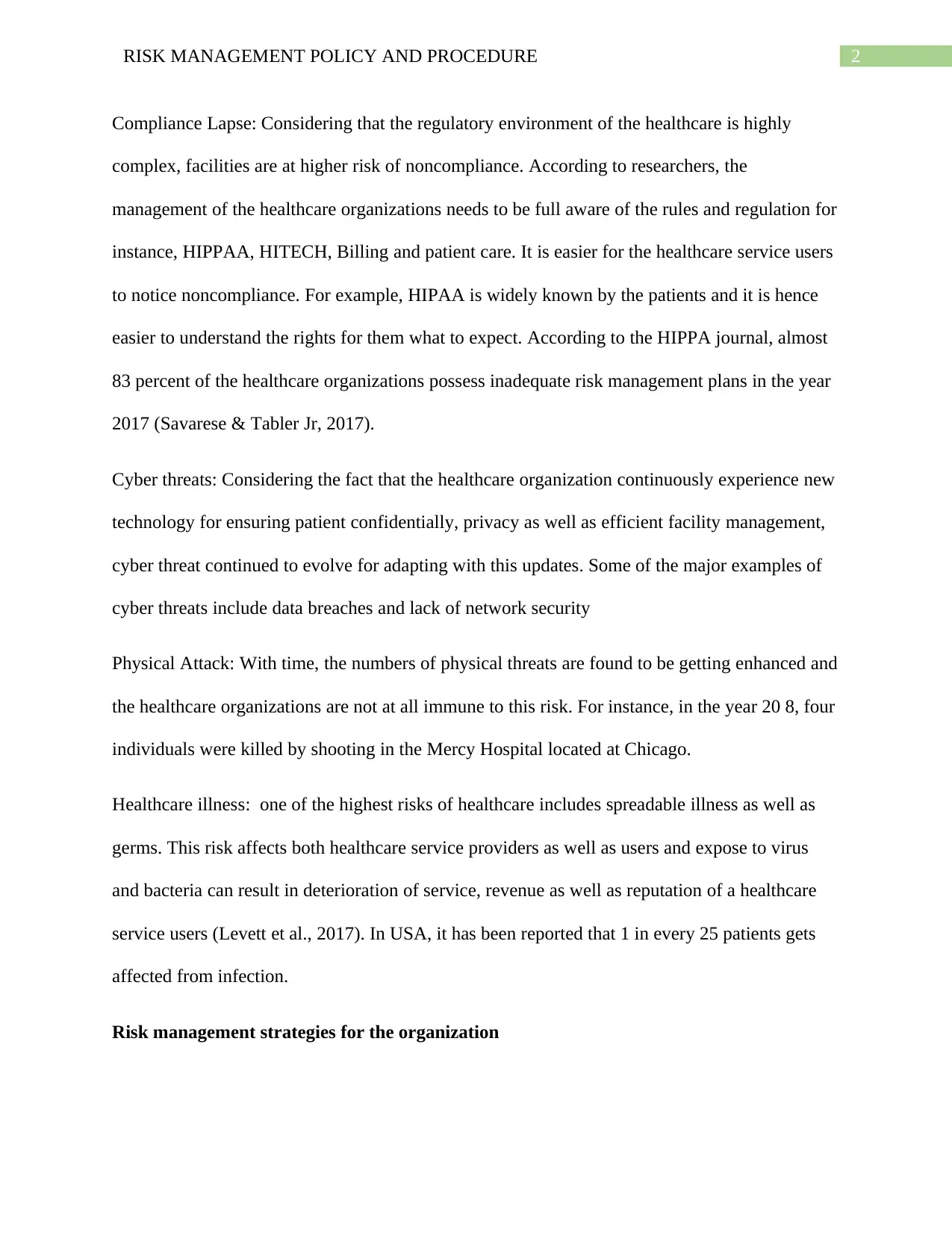
2RISK MANAGEMENT POLICY AND PROCEDURE
Compliance Lapse: Considering that the regulatory environment of the healthcare is highly
complex, facilities are at higher risk of noncompliance. According to researchers, the
management of the healthcare organizations needs to be full aware of the rules and regulation for
instance, HIPPAA, HITECH, Billing and patient care. It is easier for the healthcare service users
to notice noncompliance. For example, HIPAA is widely known by the patients and it is hence
easier to understand the rights for them what to expect. According to the HIPPA journal, almost
83 percent of the healthcare organizations possess inadequate risk management plans in the year
2017 (Savarese & Tabler Jr, 2017).
Cyber threats: Considering the fact that the healthcare organization continuously experience new
technology for ensuring patient confidentially, privacy as well as efficient facility management,
cyber threat continued to evolve for adapting with this updates. Some of the major examples of
cyber threats include data breaches and lack of network security
Physical Attack: With time, the numbers of physical threats are found to be getting enhanced and
the healthcare organizations are not at all immune to this risk. For instance, in the year 20 8, four
individuals were killed by shooting in the Mercy Hospital located at Chicago.
Healthcare illness: one of the highest risks of healthcare includes spreadable illness as well as
germs. This risk affects both healthcare service providers as well as users and expose to virus
and bacteria can result in deterioration of service, revenue as well as reputation of a healthcare
service users (Levett et al., 2017). In USA, it has been reported that 1 in every 25 patients gets
affected from infection.
Risk management strategies for the organization
Compliance Lapse: Considering that the regulatory environment of the healthcare is highly
complex, facilities are at higher risk of noncompliance. According to researchers, the
management of the healthcare organizations needs to be full aware of the rules and regulation for
instance, HIPPAA, HITECH, Billing and patient care. It is easier for the healthcare service users
to notice noncompliance. For example, HIPAA is widely known by the patients and it is hence
easier to understand the rights for them what to expect. According to the HIPPA journal, almost
83 percent of the healthcare organizations possess inadequate risk management plans in the year
2017 (Savarese & Tabler Jr, 2017).
Cyber threats: Considering the fact that the healthcare organization continuously experience new
technology for ensuring patient confidentially, privacy as well as efficient facility management,
cyber threat continued to evolve for adapting with this updates. Some of the major examples of
cyber threats include data breaches and lack of network security
Physical Attack: With time, the numbers of physical threats are found to be getting enhanced and
the healthcare organizations are not at all immune to this risk. For instance, in the year 20 8, four
individuals were killed by shooting in the Mercy Hospital located at Chicago.
Healthcare illness: one of the highest risks of healthcare includes spreadable illness as well as
germs. This risk affects both healthcare service providers as well as users and expose to virus
and bacteria can result in deterioration of service, revenue as well as reputation of a healthcare
service users (Levett et al., 2017). In USA, it has been reported that 1 in every 25 patients gets
affected from infection.
Risk management strategies for the organization
⊘ This is a preview!⊘
Do you want full access?
Subscribe today to unlock all pages.

Trusted by 1+ million students worldwide
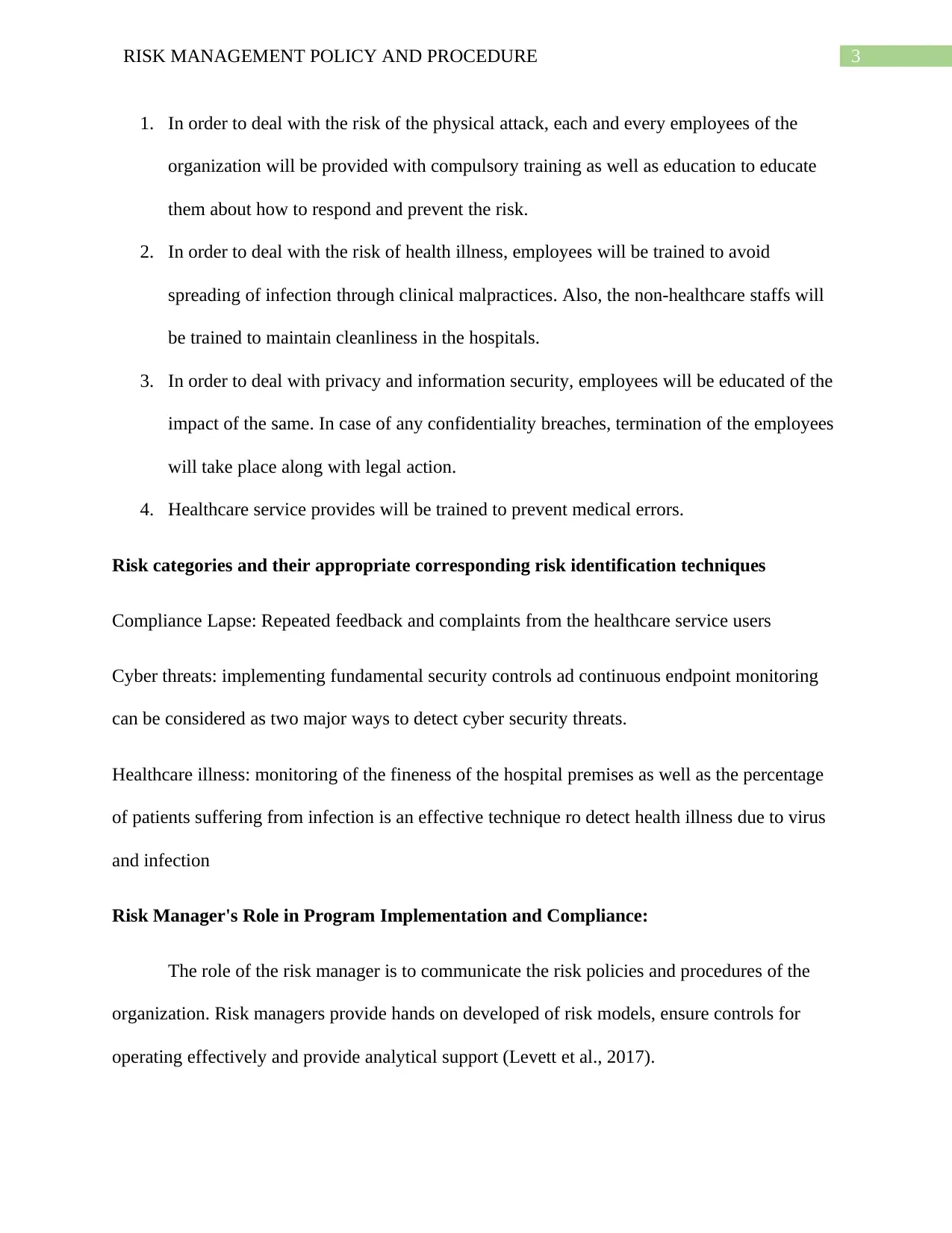
3RISK MANAGEMENT POLICY AND PROCEDURE
1. In order to deal with the risk of the physical attack, each and every employees of the
organization will be provided with compulsory training as well as education to educate
them about how to respond and prevent the risk.
2. In order to deal with the risk of health illness, employees will be trained to avoid
spreading of infection through clinical malpractices. Also, the non-healthcare staffs will
be trained to maintain cleanliness in the hospitals.
3. In order to deal with privacy and information security, employees will be educated of the
impact of the same. In case of any confidentiality breaches, termination of the employees
will take place along with legal action.
4. Healthcare service provides will be trained to prevent medical errors.
Risk categories and their appropriate corresponding risk identification techniques
Compliance Lapse: Repeated feedback and complaints from the healthcare service users
Cyber threats: implementing fundamental security controls ad continuous endpoint monitoring
can be considered as two major ways to detect cyber security threats.
Healthcare illness: monitoring of the fineness of the hospital premises as well as the percentage
of patients suffering from infection is an effective technique ro detect health illness due to virus
and infection
Risk Manager's Role in Program Implementation and Compliance:
The role of the risk manager is to communicate the risk policies and procedures of the
organization. Risk managers provide hands on developed of risk models, ensure controls for
operating effectively and provide analytical support (Levett et al., 2017).
1. In order to deal with the risk of the physical attack, each and every employees of the
organization will be provided with compulsory training as well as education to educate
them about how to respond and prevent the risk.
2. In order to deal with the risk of health illness, employees will be trained to avoid
spreading of infection through clinical malpractices. Also, the non-healthcare staffs will
be trained to maintain cleanliness in the hospitals.
3. In order to deal with privacy and information security, employees will be educated of the
impact of the same. In case of any confidentiality breaches, termination of the employees
will take place along with legal action.
4. Healthcare service provides will be trained to prevent medical errors.
Risk categories and their appropriate corresponding risk identification techniques
Compliance Lapse: Repeated feedback and complaints from the healthcare service users
Cyber threats: implementing fundamental security controls ad continuous endpoint monitoring
can be considered as two major ways to detect cyber security threats.
Healthcare illness: monitoring of the fineness of the hospital premises as well as the percentage
of patients suffering from infection is an effective technique ro detect health illness due to virus
and infection
Risk Manager's Role in Program Implementation and Compliance:
The role of the risk manager is to communicate the risk policies and procedures of the
organization. Risk managers provide hands on developed of risk models, ensure controls for
operating effectively and provide analytical support (Levett et al., 2017).
Paraphrase This Document
Need a fresh take? Get an instant paraphrase of this document with our AI Paraphraser
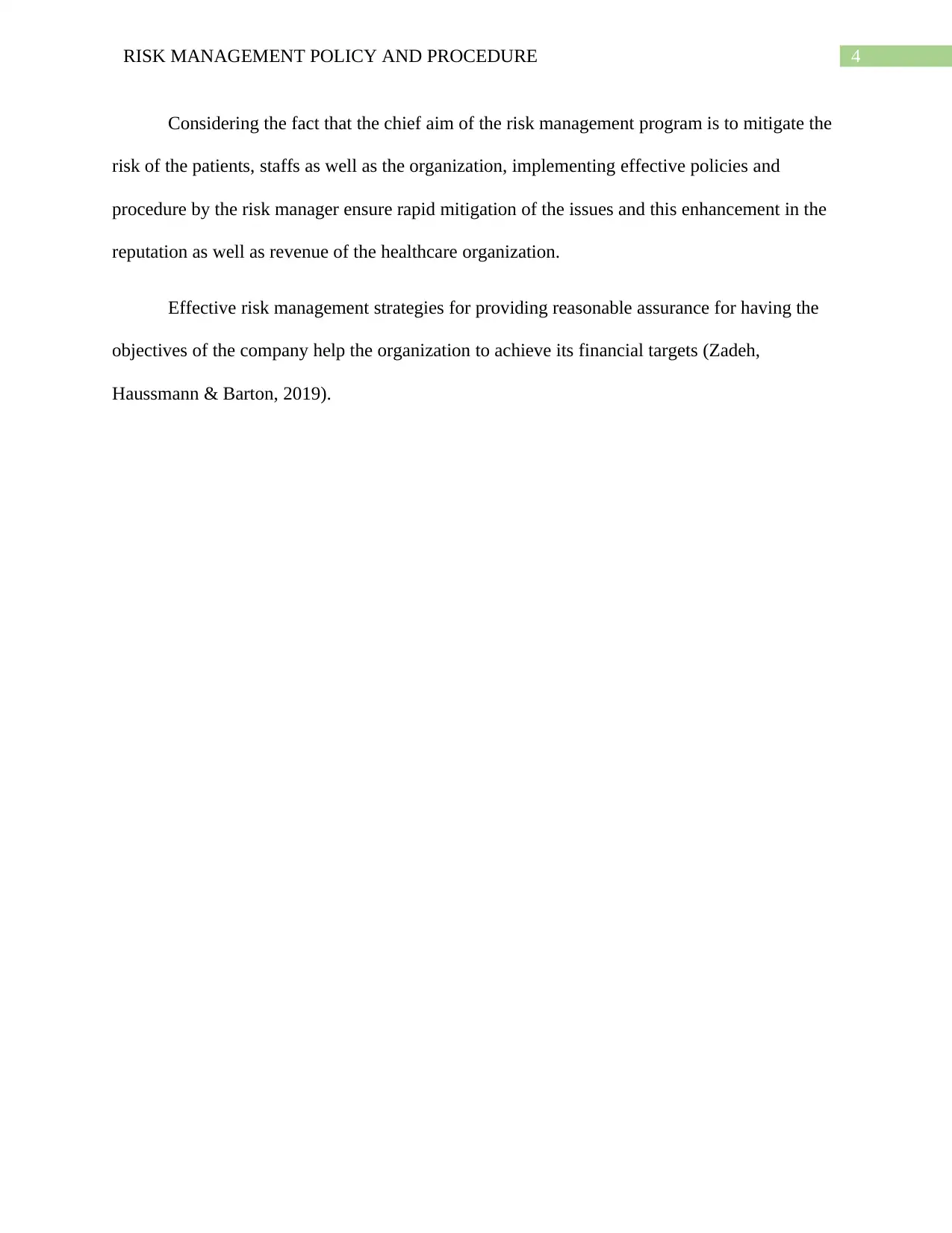
4RISK MANAGEMENT POLICY AND PROCEDURE
Considering the fact that the chief aim of the risk management program is to mitigate the
risk of the patients, staffs as well as the organization, implementing effective policies and
procedure by the risk manager ensure rapid mitigation of the issues and this enhancement in the
reputation as well as revenue of the healthcare organization.
Effective risk management strategies for providing reasonable assurance for having the
objectives of the company help the organization to achieve its financial targets (Zadeh,
Haussmann & Barton, 2019).
Considering the fact that the chief aim of the risk management program is to mitigate the
risk of the patients, staffs as well as the organization, implementing effective policies and
procedure by the risk manager ensure rapid mitigation of the issues and this enhancement in the
reputation as well as revenue of the healthcare organization.
Effective risk management strategies for providing reasonable assurance for having the
objectives of the company help the organization to achieve its financial targets (Zadeh,
Haussmann & Barton, 2019).
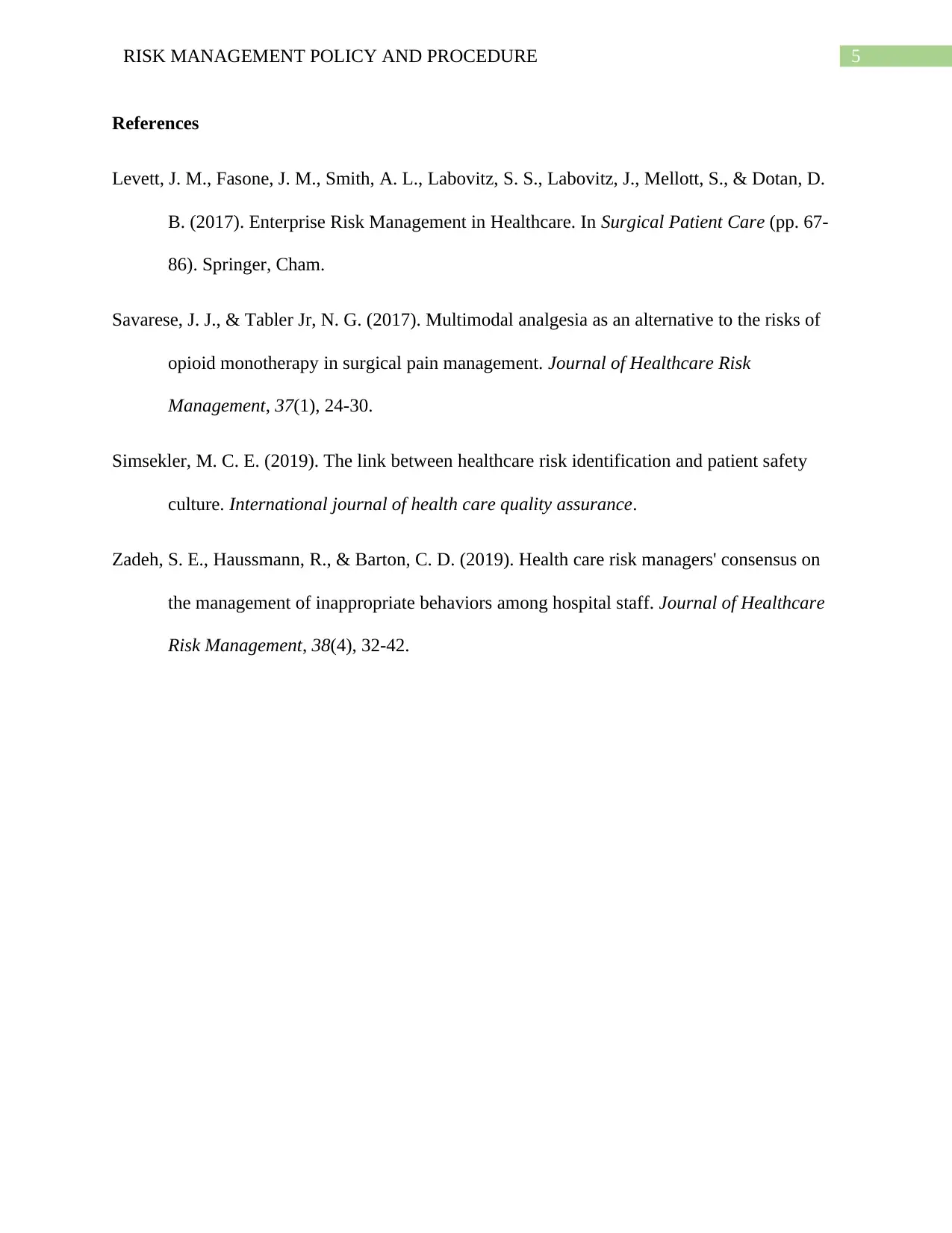
5RISK MANAGEMENT POLICY AND PROCEDURE
References
Levett, J. M., Fasone, J. M., Smith, A. L., Labovitz, S. S., Labovitz, J., Mellott, S., & Dotan, D.
B. (2017). Enterprise Risk Management in Healthcare. In Surgical Patient Care (pp. 67-
86). Springer, Cham.
Savarese, J. J., & Tabler Jr, N. G. (2017). Multimodal analgesia as an alternative to the risks of
opioid monotherapy in surgical pain management. Journal of Healthcare Risk
Management, 37(1), 24-30.
Simsekler, M. C. E. (2019). The link between healthcare risk identification and patient safety
culture. International journal of health care quality assurance.
Zadeh, S. E., Haussmann, R., & Barton, C. D. (2019). Health care risk managers' consensus on
the management of inappropriate behaviors among hospital staff. Journal of Healthcare
Risk Management, 38(4), 32-42.
References
Levett, J. M., Fasone, J. M., Smith, A. L., Labovitz, S. S., Labovitz, J., Mellott, S., & Dotan, D.
B. (2017). Enterprise Risk Management in Healthcare. In Surgical Patient Care (pp. 67-
86). Springer, Cham.
Savarese, J. J., & Tabler Jr, N. G. (2017). Multimodal analgesia as an alternative to the risks of
opioid monotherapy in surgical pain management. Journal of Healthcare Risk
Management, 37(1), 24-30.
Simsekler, M. C. E. (2019). The link between healthcare risk identification and patient safety
culture. International journal of health care quality assurance.
Zadeh, S. E., Haussmann, R., & Barton, C. D. (2019). Health care risk managers' consensus on
the management of inappropriate behaviors among hospital staff. Journal of Healthcare
Risk Management, 38(4), 32-42.
⊘ This is a preview!⊘
Do you want full access?
Subscribe today to unlock all pages.

Trusted by 1+ million students worldwide
1 out of 6
Related Documents
Your All-in-One AI-Powered Toolkit for Academic Success.
+13062052269
info@desklib.com
Available 24*7 on WhatsApp / Email
![[object Object]](/_next/static/media/star-bottom.7253800d.svg)
Unlock your academic potential
Copyright © 2020–2025 A2Z Services. All Rights Reserved. Developed and managed by ZUCOL.





